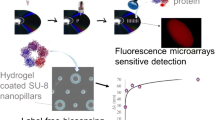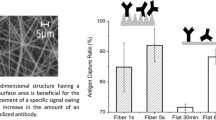Abstract
We demonstrate a localized protein immobilization method based on controlled physical adsorption on the three-phase boundary of an aqueous phase, a gas phase, and a polymeric material. By imprinting micrometer and sub-micrometer pillars onto a polymeric foil, superhydrophobic surfaces are fabricated. Those structures force the fluid locally into the Cassie–Baxter state and generate an artificial three-phase boundary at the edges of the imprinted pillars. First, fluorescence-labeled bovine serum albumin (BSA) and streptavidin dissolved in various buffer solutions are utilized to investigate protein adsorption on the structured surfaces. A stable adsorption of the respective protein on the three-phase boundary is observed. The following experiments use streptavidin adsorbed on the pillars to immobilize biotinylated antibodies for analyte detection. The pillars are passivated with an excess concentration of BSA to reduce nonspecific protein adsorption. Implemented in a lab-on-a-chip device, the proposed immobilization method is utilized in a sandwich assay to detect the inflammation marker C-reactive protein in human serum, showing the potential of this immobilization method for diagnostic applications. The method overcomes laborious procedures to immobilize proteins on thermoplastic materials, which enables the fast transfer of point-of-care applications from research to commercial scale.









Similar content being viewed by others
References
Ansar W, Ghosh S (2013) C-reactive protein and the biology of disease. Immunol Res 56:131–142. doi:10.1007/s12026-013-8384-0
Becker H, Gärtner C (2008) Polymer microfabrication technologies for microfluidic systems. Anal Bioanal Chem 390:89–111. doi:10.1007/s00216-007-1692-2
Bernard A, Renault JP, Michel B, Bosshard HR, Delamarche E (2000) Microcontact printing of proteins. Adv Mater 12:1067–1070. doi:10.1002/1521-4095(200007)12:14<1067:aid-adma1067>3.0.co;2-m
Bruckbauer A, Zhou DJ, Ying LM, Korchev YE, Abell C, Klenerman D (2003) Multicomponent submicron features of biomolecules created by voltage controlled deposition from a nanopipet. J Am Chem Soc 125:9834–9839. doi:10.1021/ja035755v
Cassie ABD, Baxter S (1944) Wettability of porous surfaces. Trans Faraday Soc 40:546–551. doi:10.1039/TF9444000546
Chen H, Yuan L, Song W, Wu Z, Li D (2008) Biocompatible polymer materials: role of protein–surface interactions. Prog Polym Sci 33:1059–1087. doi:10.1016/j.progpolymsci.2008.07.006
Chłopek J, Czajkowska B, Szaraniec B, Frackowiak E, Szostak K, Béguin F (2006) In vitro studies of carbon nanotubes biocompatibility. Carbon 44:1106–1111. doi:10.1016/j.carbon.2005.11.022
Deng Y, Zhu XY, Kienlen T, Guo A (2006) Transport at the air/water interface is the reason for rings in protein microarrays. J Am Chem Soc 128:2768–2769. doi:10.1021/ja057669w
Dörner K (2009) Klinische Chemie und Hämatologie, 7th edn. Thieme, Stuttgart
Duffy DC, McDonald JC, Schueller OJA, Whitesides GM (1998) Rapid prototyping of microfluidic systems in poly(dimethylsiloxane). Anal Chem 70:4974–4984. doi:10.1021/ac980656z
Gao D, Lin D-Q, Yao S-J (2007) Mechanistic analysis on the effects of salt concentration and pH on protein adsorption onto a mixed-mode adsorbent with cation ligand. J Chromatogr B 859:16–23. doi:10.1016/j.jchromb.2007.08.044
Halldorsson S, Lucumi E, Gomez-Sjoeberg R, Fleming RMT (2015) Advantages and challenges of microfluidic cell culture in polydimethylsiloxane devices. Biosens Bioelectron 63:218–231. doi:10.1016/j.bios.2014.07.029
Heckele M, Bacher W, Muller KD (1998) Hot embossing—the molding technique for plastic microstructures. Microsyst Technol 4:122–124. doi:10.1007/s005420050112
Holden MA, Cremer PS (2003) Light activated patterning of dye-labeled molecules on surfaces. J Am Chem Soc 125:8074–8075. doi:10.1021/ja035390e
Jena RK, Chester SA, Srivastava V, Yue CY, Anand L, Lam YC (2011) Large-strain thermo-mechanical behavior of cyclic olefin copolymers: application to hot embossing and thermal bonding for the fabrication of microfluidic devices. Sens Actuators B Chem 155:93–105. doi:10.1016/j.snb.2010.11.031
Jeon JS, Chung S, Kamm RD, Charest JL (2011) Hot embossing for fabrication of a microfluidic 3D cell culture platform. Biomed Microdevices 13:325–333. doi:10.1007/s10544-010-9496-0
Kashaninejad N, Chan WK, Nam-Trung N (2012) Eccentricity effect of micropatterned surface on contact angle. Langmuir 28:4793–4799. doi:10.1021/la300416x
Khang G, Lee HB, Park JB (1995) Biocompatibility of polysulfone 1. Surface modifications and characterizations. Bio-Med Mater Eng 5:245–258
Kim E, Xia Y, Whitesides GM (1995) Polymer microstructures formed by moulding in capillaries. Nature 376:581–584
McDonald JC, Whitesides GM (2002) Poly(dimethylsiloxane) as a material for fabricating microfluidic devices. Acc Chem Res 35:491–499. doi:10.1021/ar010110q
Meyers L, Frawley T, Goss S, Kang C (2015) Ebola virus outbreak 2014: clinical review for emergency physicians. Ann Emerg Med 65:101–108. doi:10.1016/j.annemergmed.2014.10.009
Norde W, Lyklema J (1991) Why proteins prefer interfaces. J Biomater Sci Polym Ed 2:183–202
Osborne L, Knight R, Santis G, Hodson M (1991) A mutation in the 2nd nucleotide binding fold of the cystic-fibrosis gene. Am J Hum Genet 48:608–612
Ostuni E, Chen CS, Ingber DE, Whitesides GM (2001) Selective deposition of proteins and cells in arrays of microwells. Langmuir 17:2828–2834. doi:10.1021/la001372o
Patankar NA (2003) On the modeling of hydrophobic contact angles on rough surfaces. Langmuir 19:1249–1253. doi:10.1021/la026612+
Shirtcliffe NJ, Aqil S, Evans C, McHale G, Newton MI, Perry CC, Roach P (2004) The use of high aspect ratio photoresist (SU-8) for super-hydrophobic pattern prototyping. J Micromech Microeng 14:1384–1389. doi:10.1088/0960-1317/14/10/013
Shirtcliffe NJ, McHale G, Atherton S, Newton MI (2010) An introduction to superhydrophobicity. Adv Colloid Interface Sci 161:124–138. doi:10.1016/j.cis.2009.11.001
Song H-M, Lee C-S (2008) Simple fabrication of functionalized surface with polyethylene glycol microstructure and glycidyl methacrylate moiety for the selective immobilization of proteins and cells. Korean J Chem Eng 25:1467–1472
Steidle NE, Schneider M, Ahrens R, Worgull M, Guber AE (2013) Fabrication of polymeric microfluidic devices with tunable wetting behavior for biomedical applications. In: Conference proceedings: annual international conference of the IEEE Engineering in Medicine and Biology Society IEEE Engineering in Medicine and Biology Society Annual Conference 2013, pp 6659–6662. doi:10.1109/embc.2013.6611083
Suh KY, Seong J, Khademhosseini A, Laibinis PE, Langer R (2004) A simple soft lithographic route to fabrication of poly(ethylene glycol) microstructures for protein and cell patterning. Biomaterials 25:557–563. doi:10.1016/s0142-9612(03)00543-x
Waldbaur A, Rapp H, Länge K, Rapp BE (2011) Let there be chip-towards rapid prototyping of microfluidic devices: one-step manufacturing processes. Anal Methods 3:2681–2716. doi:10.1039/c1ay05253e
Waldbaur A, Waterkotte B, Schmitz K, Rapp BE (2012) Maskless projection lithography for the fast and flexible generation of grayscale protein patterns. Small 8:1570–1578. doi:10.1002/smll.201102163
Worgull M (2009) Hot embossing: theory and technology of microreplication. Micro and nano technologies. William Andrew Publishing, Boston
Acknowledgments
The authors would like to thank T. Robinson for capturing the laser scanning microscopy images. Thanks go to P. Abaffy and G. Papagno for capturing the SEM micrographs and L. Zimmermann and M. Röhrig for supplying the hot embossing mold inserts. N. Steidle would like to thank E. Rubiu and P. Tritschler for their help preparing the samples. This work is supported by the Bürkert Technology Center (BTC), a cooperation between Bürkert Werke GmbH & Co. KG and the Institute of Microstructure Technology (IMT) at the Karlsruhe Institute of Technology (KIT). This work was carried out with the support of the Karlsruhe Nano Micro Facility (KNMF), a Helmholtz Research Infrastructure at KIT.
Author information
Authors and Affiliations
Corresponding author
Rights and permissions
About this article
Cite this article
Steidle, N.E., Hahn, T., Bader, C. et al. Localized protein immobilization on microstructured polymeric surfaces for diagnostic applications. Microfluid Nanofluid 20, 30 (2016). https://doi.org/10.1007/s10404-015-1696-8
Received:
Accepted:
Published:
DOI: https://doi.org/10.1007/s10404-015-1696-8




